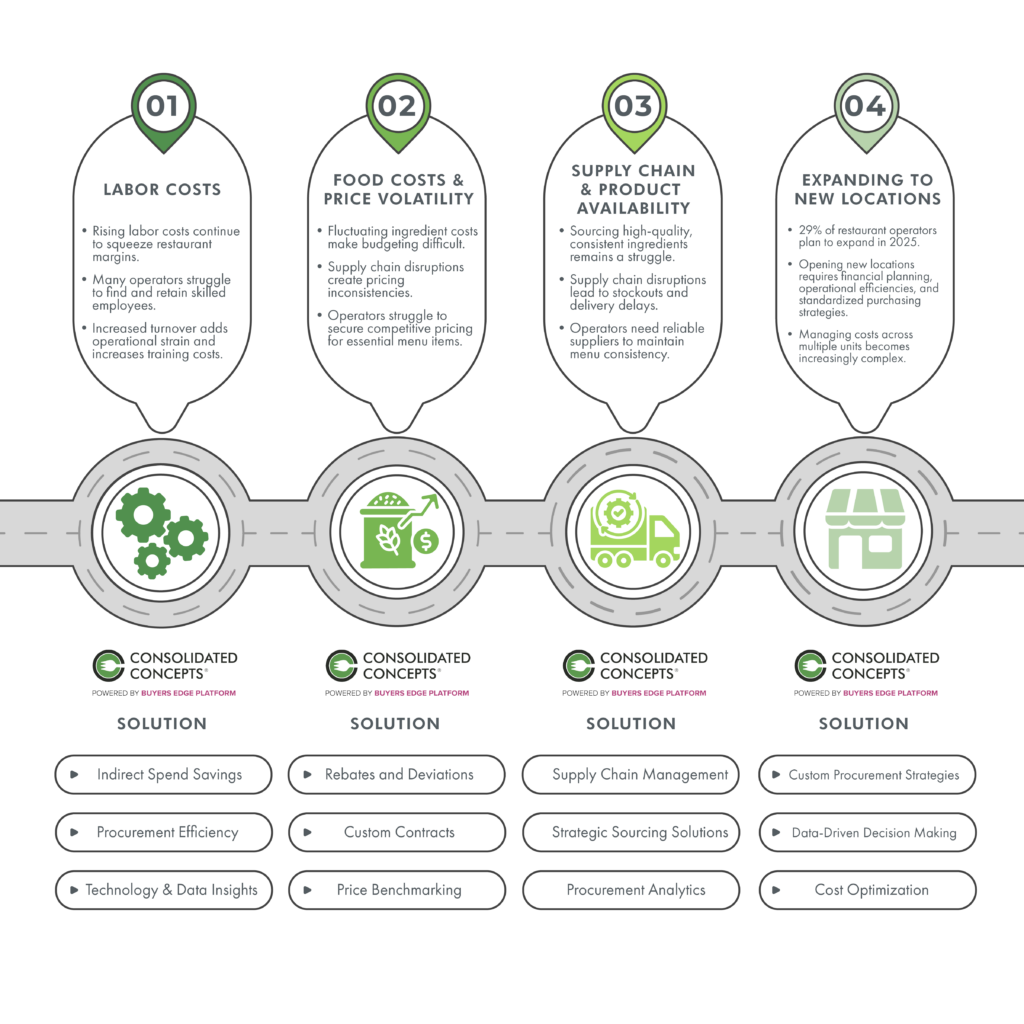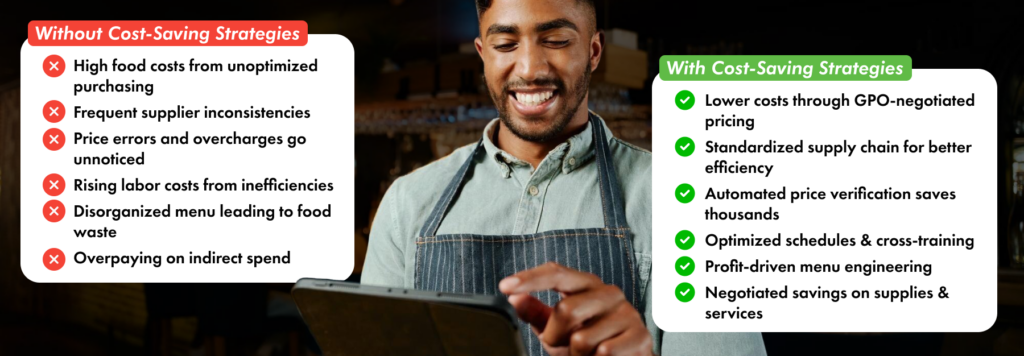Restaurant Growth Strategy: How Operators Can Scale Profitably
The restaurant industry is no stranger to challenges, and this year many operators anticipate facing the same hurdles that have defined recent years. Labor costs, food costs, and recruiting and retaining employees remain top concerns for both full-service and limited-service restaurant operators. Despite these challenges, growth is on the horizon—29% of operators plan to expand and open new locations in 2025.
So, how can multi-unit restaurant operators navigate rising costs, workforce struggles, and supply chain complexities while still driving profitability and expansion? The answer lies in leveraging strategic partnerships and advanced solutions designed to streamline operations and optimize costs. A well-planned restaurant growth strategy can help operators scale efficiently while maintaining financial health.
Rebates & Deviations: Reducing Food Costs at Scale
Food costs continue to be a top concern for restaurant operators, and as commodity prices fluctuate, managing expenses becomes increasingly difficult. Through Consolidated Concepts, multi-unit operators gain access to powerful cost-saving programs, including rebates and deviations.
- Rebates: By leveraging the collective purchasing power of multi-unit operators, Consolidated Concepts negotiates exclusive rebates on essential ingredients and supplies. These rebates put money back into your business, helping to offset rising costs and support your restaurant growth strategy.
- Deviations: Custom pricing agreements ensure you’re paying the most competitive prices across all your locations. This approach prevents price discrepancies and helps control costs, allowing you to expand without financial strain.
Data & Technology: Powering Smarter Growth
Having real-time access to purchasing data and analytics is crucial for making informed business decisions. Consolidated Concepts provides multi-unit operators with advanced procurement technology that delivers deep insights into spending patterns, cost trends, and supplier performance.
- Price verification tools help ensure that you’re being charged correctly for every invoice, eliminating overcharges and improving cost accuracy.
- Purchasing analytics provide real-time visibility into food and supply costs, allowing operators to make data-driven decisions that drive savings and operational efficiency.
- Forecasting technology helps operators anticipate cost fluctuations, making it easier to budget for future purchases.
Supply Chain Management: A Growth Strategy Essential
Between ongoing supply chain disruptions and increased demand for quality ingredients, managing procurement has never been more complex. Consolidated Concepts helps multi-unit restaurant operators streamline their supply chains by optimizing vendor relationships, ensuring product availability, and improving overall efficiency.
- Strategic sourcing solutions help operators secure reliable, cost-effective ingredients while maintaining quality and consistency—an essential aspect of any restaurant growth strategy.
- Distribution management services prevent stockouts, delays, and supply chain inefficiencies that could impact operations.
- Customized procurement strategies help multi-unit operators source the best products while balancing cost and quality.
Produce Management: Elevating Freshness in Your Growth Plan
Consumers continue to demand fresh, high-quality ingredients, making produce management a top priority for restaurants. Consolidated Concepts provides operators with expert produce procurement services to help maintain consistency and reduce waste.
- Sourcing from a trusted network of suppliers ensures that operators receive the freshest, highest-quality produce year-round.
- Quality assurance support helps ensure that every shipment meets your restaurant’s standards.
- Price benchmarking tools allow operators to compare pricing across multiple vendors to ensure they’re getting the best deal—a key component of a cost-efficient restaurant growth strategy.
Custom Contracts: Aligning Pricing with Growth Goals
Every restaurant brand has unique needs, and off-the-shelf supplier agreements don’t always align with business goals. That’s why Consolidated Concepts works with multi-unit operators to create customized contracts that align with their purchasing priorities.
- Negotiated agreements help operators secure exclusive pricing and terms that align with their long-term growth strategies.
- Category management support ensures that operators are optimizing their purchasing in key areas like proteins, beverages, and disposables.
- Flexibility in supplier selection allows restaurant brands to work with vendors that best suit their operational needs.
Indirect Spend Savings: Reducing Costs to Scale Smarter
Food costs aren’t the only expenses putting pressure on restaurant margins—indirect spend categories like equipment, utilities, and maintenance also contribute to rising operational costs. Consolidated Concepts helps operators reduce indirect spend through exclusive programs and partnerships.
- Discounted pricing on essential supplies including kitchen equipment, uniforms, linens, and more.
- Technology solutions for non-food procurement streamline purchasing for facilities management, cleaning supplies, and other operational needs.
- Energy efficiency programs help operators lower utility costs through optimized energy usage and rebate opportunities—a critical factor in sustainable restaurant growth.
Executing a Winning Restaurant Growth Strategy
With nearly a third of restaurant operators planning to expand in 2025, having a restaurant growth strategy in place is critical for success. Consolidated Concepts provides the tools, data, and supplier partnerships needed to scale efficiently while maintaining financial health.
By leveraging rebates, data analytics, supply chain management, produce procurement, custom contracts, and indirect spend savings, multi-unit operators can address their biggest challenges while positioning their business for long-term growth.
Want to see how Consolidated Concepts can support your restaurant growth strategy? Fill out the form below and get in touch with our restaurant experts today!



